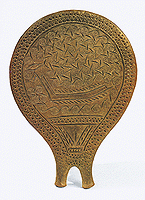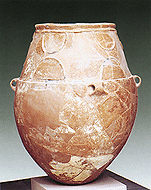The main feature of the Bronze Age is the development of metalworking and the use of bronze alloys from the beginning of the 3rd millenium BC for the manufacture of durable tools and weapons. These brought about the improvement and expansion of many productive activities (agriculture, tool manufacture, navigation etc.). The economy of the Bronze Age is based on three axes: agrarian production (agriculture and animal husbandry), trade and artisanship.
The agrarian economy includes the cultivation of cereals and legumes. Moreover, already from the Early Bronze Age the cultivation of the vine and olive tree begins while it becomes systematic during the Late Bronze Age. Animal husbandry comprises the breeding of sheep, goat and cattle, the products of which are essential for nutrition and the textile manufacture. The improvement of tool manufacture effects increase of agricultural production and surplus which could cover the nutritional needs of the Bronze Age communities. An eventual lack of nutritional goods in small and infertile islands such as the Cyclades were covered either by alternative crops, e.g. strong barley instead of wheat or by imports from other regions.
The development of marine trade is due to the necessity of discovering raw materials (obsidian, metals), acquiring expertise and promoting exchangeable agricultural and manufactured goods. Its development is connected to that of navigation in the Aegean in the beginning of the 3rd millenium BC. The finds from settlements and cemeteries indicate clearly the pure Aegean character of trade and contribute to the diagnosis of dense local or extensive exchange networks but also to that of the intensity of cultural contacts in the different periods of the Bronze Age.
In the beginning of the Early Bronze Age labour division and technological specialization occur in the insular settlements. The main specialized productive activities are pottery, stone carving, bone carving, marble-sculpture, textile manufacture, hide processing, metalworking, jewellery-making and fresco painting. These activities occupy, depending on the case, one person, a small group, one or even more families of a community. In many settlements, workshops, for example, metalworking or stone carving workshops are discovered. These indicate clearly that these professions were bequeathed from one generation to the other already from the 3rd millenium BC.

with ship. Early Cycladic II.

incised decoration. Early Cycladic II.